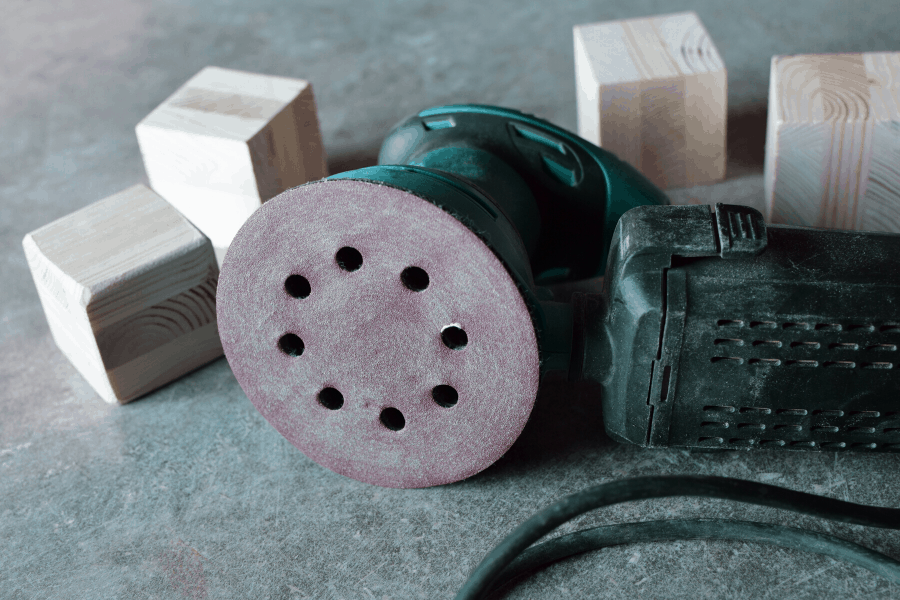
A random orbital sander is a hand-held sander that vibrates or orbits in a random pattern. There are so many helpful options when it comes to sanding down your project. Each tool has a specific purpose and function that separates it from the others. I’ve researched through the internet and put together a quick summary on the Random Orbital Sander.
What is a random orbital sander used for? A random orbital sander is used for prepping surfaces, sanding off paint and varnish, shaping wood and plastic, polishing and removing rust from metal, fixing imperfections in joinery, removing slight cupping from your wood, removing dents, gouges, and scratches.
This summary is just scratching the surface on random orbital sanders; keep reading below to get a more in-depth look at random orbital sanders and what they are used for.
Table of Contents
What Is A Random Orbital Sander Used For?
A random orbital sander, also known as a palm sander, is a hand-held sander that vibrates or orbits in a random pattern, which makes them easy to hold and control for detailed sanding work and feature a wide variety of uses on wood or metal projects, ranging from furniture to bodywork on cars, making them one of the most versatile and useful powered sanders.
Orbital sanders work great for sanding off paint or varnish, sanding or shaping wood and plastic, and polishing or removing rust from metal
Orbital sanders come in two types–square and round. Square orbital sanders only vibrate in small circles, while round random orbit sanders spin slowly while also vibrating in small circles. Square orbital sanders aren’t as powerful as round orbital sanders and can leave more marks or scratches behind, but due to their square shape, they are a lot easier to use in corners or against flat edges. Random orbital sanders can sand more quickly than a regular orbital sander, and due to the random orbit, are less likely to leave scratches behind, but can’t get into corners or along edges easily.
The best way to use an orbital sander is to keep the sander moving slowly (don’t stop and don’t rush), don’t push down too hard while using it, overlap your passes, and making sure you are using the appropriate grit level sandpaper for your project. Some people even dual-wield palm sanders when faced with a large project, but it may take some practice to get the hang of using two palms sanders simultaneously.
And while an orbital sander will sand much more quickly than by hand, it won’t compare with a belt sander for removing large amounts of material, but when it comes to finishing a project, an orbital sander excels in the details. One downside of orbital sanders is that the vibration can be hard on your hands, especially when they are used for extended periods of time.
You can get electric or air-powered orbital sanders, which allow you to use them under different conditions. For example, if you are framing a house with air nailers and need to do a little sanding, an air-powered sander will allow you to use the air hoses you would already have available without having to find and roll out an extension cord, whereas if you don’t have an air compressor, it will probably be much more convenient to use an electric sander.
Round orbital sanders typically use a 5” or 6” disc and are attached either with an adhesive or velcro backing. Round orbital sanding discs are usually freely interchangeable with rotary sanding discs, meaning you won’t have to buy specialized sanding discs for your round orbital sander, while most square orbital sanders are sized to accept ¼ of a standard size sanding sheet.
Many orbital sanders include built-in dust collection systems, and can usually be easily hooked up to a shop vacuum to keep your workspace clean and dust-free.
Whatever you are working on, a random orbital sander is a useful tool that you won’t want to go without.
Click this link to browse through Random Orbital Sander options on Amazon.
Random Orbital Sander Uses
-remove paint from wood.
-refinish furniture.
-sand awkward spaces.
-prepping surfaces
-sanding off paint and varnish
-shaping wood and plastic
-polishing and removing rust from metal
-fixing imperfections in joinery
-removing slight cupping from your wood
-removing dents, gouges, and scratches.
A random orbital sander is one of the most versatile tools you can have in your arsenal, and there are numerous ways you can put it to good use. Whether you’re removing paint from wood, refinishing furniture, or sanding off paint and varnish, a random orbital sander can make quick work of the task at hand.
How To Use A Random Orbital Sander
Subscribe to HouseImprovements on Youtube
Woodworking Joke:
The old man sitting on the porch in front of the woodshop looked especially happy. When the woman vent in to enquire about some cabinets, she couldn’t help but stop and chat for a minute.
“You look so content!” she gushed. “Tell me, what’s your secret?”
“Well,” he said in a quavering voice, “I smoke three packs a day, drink a case of whiskey every week, don’t believe in dust collectors, never wear a mask, never eat vegetables or exercise, and have bacon at every meal.”
“My gosh!” she replied. “And how old are you now?”
“I’ll be twenty-six on Friday.”

